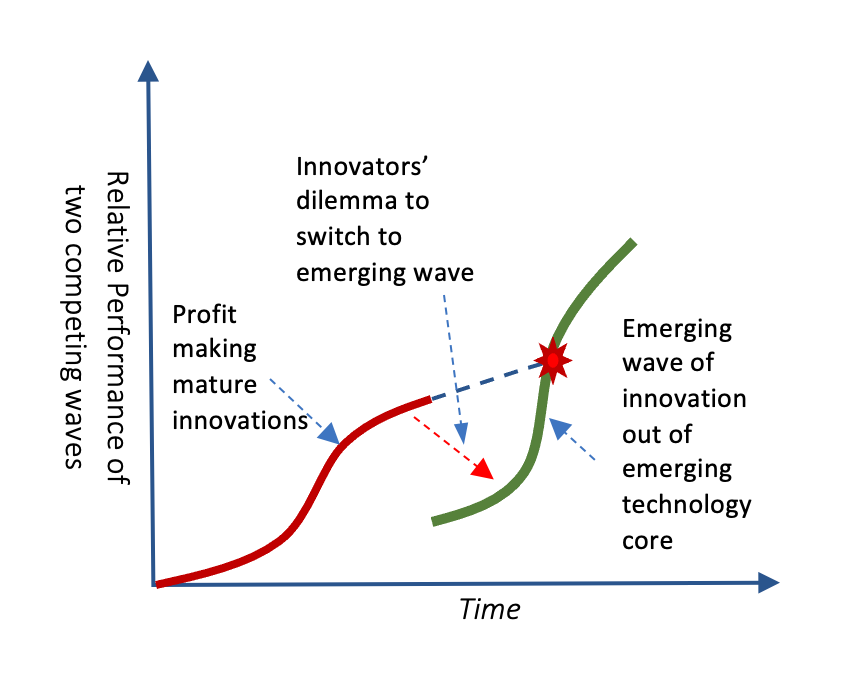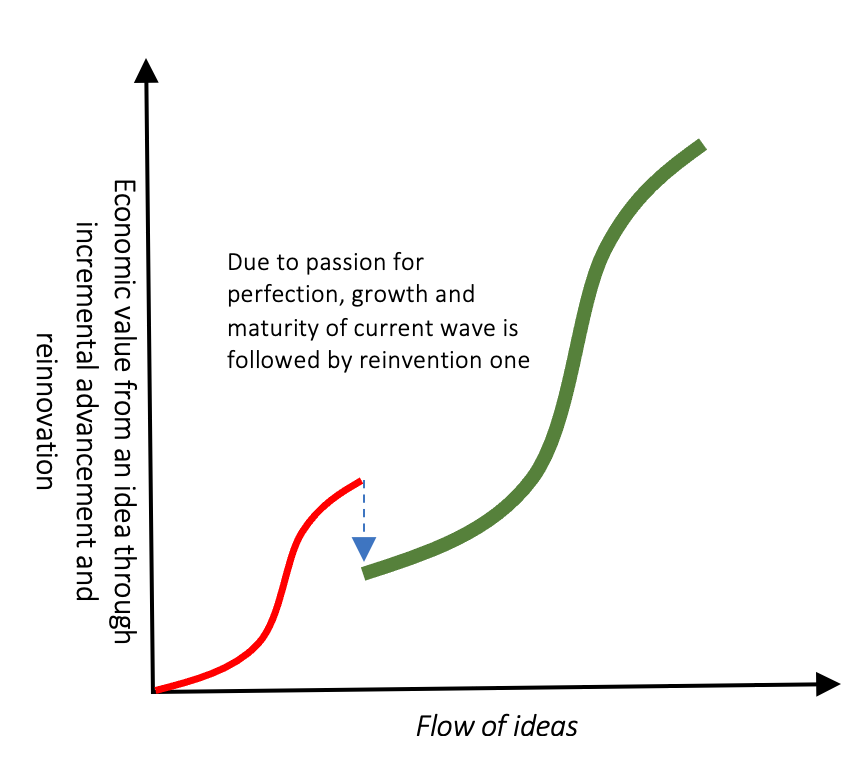Despite knowing the age-old saying, don’t reinvent the wheel, why are we after Reinvention? In retrospect, Apple, Tesla, Microsoft, Sony, and many others have created fortune out of reinvention. Due to this reinvention, many technology icons like Nokia, RIM, DEC, Kodak, and RCA suffered from destruction. Hence, for being a global technology powerhouse, China has been after reinvention with its ‘Made in China 2025’ strategy. Reinvention does not refer to remaking the same thing. It’s about the recreation of existing mature products by changing the technology core. It’s at the heart of Schumpeter’s Creative Destruction and Christensen’s Disruptive Innovation theories. We succeed in giving new growth paths to existing mature products through reinvention. The journey of recreation out of reinvention forms waves of creative destruction. In addition to destroying the demand for mature products, they also take the form of disruptive innovation, causing suffering to incumbent firms and migrating inventions.
Every invention begins the journey in an embryonic form. Although automobiles, television, computer, airplane, and microwave ovens have grown as large businesses, there were hardly any customers at the beginning of their lifecycles. Hence, innovators start the journey of incremental advancement, making them increasingly better and cheaper. But invariably, waves of Incremental innovation around the same technology cores reach saturation. Sometimes, new technology cores emerge to overcome it. Hence, to create a new growth path, innovators jump into recreating them by changing the technology core. Despite the formation of primitive alternatives, in certain instances, reinvented products grow as waves of creative destruction. Reinvented alternatives grow as better and cheaper alternatives, resulting in a loss of demand for mature products. Hence, product lifecycles keep evolving in episodic form, having a period of incremental innovation followed by reinvention. Due to switching failure, incumbent firms also suffer from destructive effects.
Episodic model of product lifecycle evolution:

Examples of winners and losers:
Once the reinvention waves reach the inflection point, incumbent products suffer from loss of demand. In certain instances, incumbent firms fail to switch to emerging waves. As a result, once-dominant firms also suffer from destruction. On the other hand, new entrants experience rapid growth due to the growing appeal of reinvented products. Consequentially, the dynamics of reinvention create both winners and losers.

For example, Sony pursued the journey of camera reinvention. Despite a desperate move near the inflection point, Kodak suffered from a significant burn, resulting in the rise of the dominance of Sony in the camera industry. Similarly, due to the reinvention of PC by changing the text-based interface with graphical user interface, late entrant Apple grew as a dominant PC maker. On the other hand, once large PC makers, like Commodore International, disappeared. Furthermore, a growing PC wave also caused destruction to minicomputers and their makers, like DEC.
Similarly, the reinvention of Walkman as iPod destroyed Sony’s portable music business and gave the 2nd life to Apple. The reinvention of the smartphone by Apple made once unsinkable dominant firms like RIM and Nokia absent in handset making. There have been many such examples. As reinvention creates winners by destroying incumbent firms, inventions migrate. They not only migrate from losing to winning firms, but also, they may migrate across the boundaries of nations.
Underlying switching barriers of incumbent firms:
The question could be, why do incumbent firms fail to switch to emerging waves and suffer from loss of business to new entrants? Does it mean that incumbent firms are weaker in technology, seed fund, human capital, brand value, and complementary capacities? Invariably, the answer is the other way around. In many cases, incumbent firms which end up being losers are the inventors or forerunners of emerging technology cores used for reinvention. For example, GE invented red LED; but it lost its lighting business to Nichia due to the reinvention of the light bulb. Hence, during the process of light bulb reinvention, GE fell and Nichia rose.
Similarly, Kodak was the first to get a patent for digital cameras. Before Sony, RCA attempted to make Transistor radio. Despite it, why do incumbent firms, having expertise and dominant positions in making products around mature technology core, fail to switch, let alone to lead?
First of all, the emerging technology cores are fraught with pervasive uncertainties. The next one is that reinvented products appear in primitive form generating loss-making revenue. The next one is about the marginal cost-benefit analysis-based management decision-making culture of incumbent firms. Hence, management faces a Dilemma to reallocate resources from profit-making incumbent businesses to loss-making uncertain ones. On the other hand, the new entrant has only one option: turning the loss-making emerging wave into a profitable one.
Switching move near inflection point fails:

Often, near the inflection point, incumbent firms make a desperate attempt to switch to an emerging creative wave of destruction. But perpetually, they fail due to patent barriers and mitch match of organizational competence and complementary capacities. Furthermore, near the inflection point, drivers of emerging waves keep showing quite a high rate of performance improvement (ramp-up phase), giving late entrants little or no catchup opportunities. As the barrier to switching keeps growing with the advancement of the emerging wave, both incumbent products and producers suffer from Schumpeter’s creative destruction effect. We term the suffering of incumbent firms due to switching failure as Christenson’s disruptive innovation.
Japan’s Industrial success due to reinvention:
During post-WWII, the invention of the transistor technology core became a blessing for Japan in building its industrial economy. Soon after its invention, Sony and several other Japanese companies embarked on licensing, assimilating, and advancing the transistor. They targeted to use it to reinvent an array of products. The success started through Sony’s reinvention of Radio and Television. Japanese companies successfully reinvented all types of consumer electronics products, beginning from VCR to audiotape players. Japanese companies also focused on fine chemical, pure silicon, and processing equipment to fuel the production and use of silicon chips. For example, in the early 1980s, NEC emerged as the largest silicon chip maker in the world. In addition to the camera, Japanese companies have also established leadership roles in various products such as displays, computer storage, watches, light bulbs, and many others through reinvention.
Reinvention has turned USA’s invention bucket leaky:
Due to a weak capacity in reinvention, the USA lost its edge in many products and production processes. For example, with RCA’s invention of electronic television, the USA became a global leader in TV production in the 1950s. But within 20 years, it lost it to Japanese makers. Similarly, IBM has lost its computer storage business to Toshiba. In the reinvention race, the USA has also lost telephone equipment business to the Europeans, and lately, to China. The list goes on with the loss of light bulbs, renewable energy, and camera. Recently, the USA has lost the edge of silicon processing due to Taiwan’s superior performance in incremental process technology innovation. Consequentially, USA’s innovation basket appears to be a leaky bucket. However, there have been successes too. For example, Steve Jobs’ innovation secret has been in reinvention.
Made in China 2025 strategy:
Upon being a global manufacturing hub, China has aspired to be a producer and exporter of ideas. As invention takes a long time and joining in the incremental innovation race at a later stage is quite a tough call, China has targeted reinvention. Perhaps, Japan’s success in establishing leadership roles in significant products through reinventions has encouraged China to scale up the model. Among others, China has embarked on the reinvention race of automobiles. Within a short span of time, China has emerged as a dominant supplier of crucial building blocks of Electric vehicles (EVs)—lithium-ion batteries. China’s success in 5G is also an indication of reinvention success. To have a synchronized national-level response, China’s Made in 2025 is a reinvention strategy for meeting its dream of becoming a global leader in technology.
South Korea is yet to show reinvention success:
For sure, South Korea has been a remarkable success in creating an industrial economy out of innovation. But so far, the success of South Korean companies has been in incremental process and Product innovation. Although Samsung has shown a bit of global success in silicon chip processing technology, that appears to be extremely high performance in incremental innovation. On the other hand, Samsung’s success in smartphones and consumer electronics has been through imitation and incremental innovation. Due to it, despite staggering R&D investment reaching 4.5 percent of GDP, SK’s economy has been failing to sustain the growth momentum. To avail the next wave of growth, South Korea must get into reinvention.
India, Brazil, and many other less developed countries fail to comprehend reinvention:
Right after independence in 1947, India undertook a strategy of making imported products locally and engaging in scientific research for invention. Instead of focusing on incremental innovation of products and processes, India gave profit-making protection to local producers to keep making the same thing. Hence, among others, India kept making the same Ambassador car and left it as junk after 60 years. On the other hand, scientific research produced all but no noticeable innovation. It appears that India as a nation did not strategically focus even on incremental innovation, let alone reinvention. Like India, Brazil also took similar paths. Like them, all other less developed countries are just after making, whether for import substitution or contract manufacturing for foreign buyers.
Reinvention creates winners and losers through the uprising of the creative waves as incumbent firms fail to switch. As a result, successes and products migrate across the boundaries of firms and countries. Hence, due to it, Schumpeter’s creative destruction unfolds with the migration of success—creating winners and losers. It’s time to focus on this reinvention dynamics to snatch away the edge and retain it as well. There is a need for strong corporate and national competence in technology uncertainty management, forecasting, systematic ideation, and idea management in creating success out of it. In turning the potential into successful reinvention, like the LED light bulb, the journey may even require Nobel Prize-winning scientific discoveries. It demands a synchronized response of multiple stakeholders, over even decades, to fuel the creative wave to reach the inflection point.
...welcome to join us. We are on a mission to develop an enlightened community by sharing the insights of Wealth creation out of technology possibilities as reoccuring patters. If you like the article, you may encourage us by sharing it through social media to enlighten others.




